Tourism is one of the main resources of the Eloro district, as evidenced by the positive trend of development marked in the last decade, thanks to the exploitation activities financed by Eloro LAG with the Leader II programme. The baroque town of Noto, included recently in the UNESCO World Heritage List, the nature reserves of Vendicari (which is now also a CIS - Community Interest Site - Special Protection Area) and Cavagrande of the Cassibile; from the beautiful southern coasts of Portopalo and Pachino, the natural reserve of the Island of Capo Passero, the archaeological sites of great historical interest, the Eloro district has an environmental, artistic and cultural heritage invaluable and unique in the world. The Tourism Section, complementary to the Territory Section (i.e. a guide to places and destinations of the Eloro district), intends to become an operational tool available to the tourist or visitor for the best organisation of his stay and the choice of interesting routes to take.

Noto is a city in Sicily of 24,047 inhabitants of the province of Siracusa in Sicily. It is a Sicilian town it is the fourth largest Italian territory (550 km²).
Called the "capital of Baroque", in 2002 its historic center was declared a World Heritage Site by UNESCO, along with other late Baroque towns of the Val di Noto.
Web
Rosolini, feudal village, has developed into a period of more than two centuries. Its origin can be traced to the mid-fifteenth century, following the marriage between Antonio and Margarita De Platamone Podium, which is bringing the feud Cugni of Incumbao, better known as Li Salini, that is our current territory.
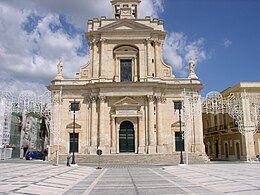 Web
Web
Avola stretches along the coast, in the territory at south of Siracusa, along one of the oldest Greek routes of Sicily: the Elorina road. The area where it is located is the "door" of a great container of cultural and environmental heritage. From the large Piazza Umberto I, already the famous, historic hexagonal Piazza Maggiore, begin the Baroque "streets" and lead to the spectacular natural reserves of Cava Grande del Cassibile and Vendicari.
The flat site of the city of Avola is placed in an extraordinary landscape between the Ionian Sea and the Iblei mountains, or between a coast with beaches of warm golden sand, and the cool air and the scents of the northwest Iblei heights that surround it. The happy peculiarities of the microclimate that determines this situation, allowed the cultivation of sugar cane - since '400 up to '800 -, grapes, almonds and lemons whose fruits continue, even today, to provide high excellence. Almond Avola, perfect oval, as Leonardo Sciascia wrote, and Nero d'Avola, which rose from the ancient wine, are famous worldwide for their distinctive flavours.
Web
 « ...Better is with long delay and long time visiting Pachino and circling across the Trinacria,
that not else, than seeing horrendous cavern, hear those scary and proud screams of those cerulean rabid dogs ... ... We crossed Pachino alpine stones , We discovered Camarina, and the fate we heard,
that pain for her was its dry pond ... "
(Virgil, Aeneid, III-1095)
« ...Better is with long delay and long time visiting Pachino and circling across the Trinacria,
that not else, than seeing horrendous cavern, hear those scary and proud screams of those cerulean rabid dogs ... ... We crossed Pachino alpine stones , We discovered Camarina, and the fate we heard,
that pain for her was its dry pond ... "
(Virgil, Aeneid, III-1095)
Pachino (Bachinu or Pachinu in Sicilian) is an Italian town of just over 22,000 inhabitants in the province of Siracusa in Sicily.
Pachino is the city that hosts the cultivation of cherry tomato IGP said, in fact, Pachino
Web
The territory now comprising Portopalo was inhabited since ancient times. The village was named in various ways: initially Cape Pachino, following Terra Noble and finally Porto Palo. The founder of Portopalo is Don Gaetano Deodato Moncada, that was concerned since 1778 and that in 1792 built at his own expenses a hundred houses around the tuna trap. The first town consisted of about 300 people, including farmers, herders and fishermen.
Until 1812, when the feudal system was abolished, Portopalo village was a suburb of Noto. Then it passed under the “Decurionate of Pachino”, until in 1974 it became an independent municipality by Dr. Salvatore Gozzo, physician and politician. The autonomy of the country, which in the meantime had assumed the full name of Portopalo, was approved in the Regional Assembly, with Regional Law No. 1 of 03/01/1975.
In 1936, as a result of the census, it was inhabited by 1,710 people, arranged in small houses along the Via Vittorio Emanuele, and was presented as a quiet country village. Most of the houses were white and cracked from the sun and salt. In almost all had a small gap ('u bagghiu) used as a stable, where it was also possible to grow a small vegetable garden.
In the country there was no water supply that would provide water to homes: women were then forced to wash clothes, to go to the well at the municipal castle Bruno of Belmonte (now Tafuri). The life of portopalesi consumed the day in the fields and in the evening the sea, the seine net in the fishery to encircle the tuna like a fence, to supplement their revenue.
Web

To develop, jointly, strategies and pilot actions to contribute to the integration of agro-food productive chains, capable, on one hand, to enhance and make more competitive the typical and quality productions of the two areas; on the second hand, to increase the level of food quality and safety, while respecting the principles of sustainable development.
Ensuring the highest levels of food quality and safety, sustainable production, rural employment and better quality of life in rural contexts, through the implementation of the bottom-up methodology. The direct involvement of the target groups, consultation and the inclusive dynamic promoted as participative protagonism of all the concerned, public and private, state and non-state stakeholders, along with the Project operative approach, will ensure appropriate opportunities for access to all the key players of the local effective development at institutional, environmental, economic and social level.
Read more

Traditional cheeses are linked to the territory of origin from which they draw peculiar characteristics defined “Biodiversity Factors “. The factors related to land, climate, raw milk, pasture, farming and the historical and cultural aspects that distinguish the production area. For these reasons, a traditional cheese can become a vector of knowledge of the place and its culture, a means of interaction between the production chain and consumers. Therefore the project idea is to promote the variety of Tunisian cheeses and territories, thanks to these factors that become “markers” and “brand” of the territory.
Read more
The project aims to adequately value the resources related to territorial identities, in particular the intangible cultural heritage and crafts of excellence, providing innovative tour discovering heritage based on common traditions and roots of the two territories, and provide concrete information on territories through a modern communication system in all seasons. Read more
At Mediterranean level, tourism has often led many countries and regions to develop the industry in a competitive way rather than in a cooperative manner. For obvious climatic reasons but also due the role played by tour operators, Mediterranean tourism destinations have based their growth essentially on a “sun and sea” vision and developed strategies aimed at maximizing short term profits instead of addressing the needs and expectations of customers and residents. In this sense, there is a real need to adopt and introduce new consumer models translated into environmentally friendly tourism products, respecting natural resources and diversifying the seasonal nature of tourism demand. UMAYYAD contributes to this objective by promoting sustainable tourism based on the synergies derived from the design of a cross-border itinerary between 6 countries sharing common history and cultural background.
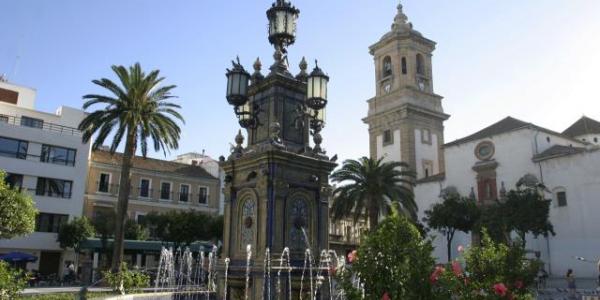 Leggere +
Leggere +
According to the WTO, tourism impact in the MED region is higher than in any other region in the world. The GDP produced by tourism in the world is close to 10% of total global GDP, and accounted for over 230 million jobs worldwide. For the European Union tourism is playing a key role in strategies for stimulating economic growth in the next few years. The exceptional social, cultural and natural heritage in the Mediterranean Basin is a factor of competitiveness and makes tourism development a growth opportunity for its regions; simultaneously its preservation is an ethical requirement, besides responding to consumer significant trends: World Travel Market Global Trends Report 2008 identifies in the desire for social and environmental responsibility, authentic travel and fair trade experiences. Leggere +
MedDiet project aims at spreading knowledge about the benefits of the Mediterranean Diet, as an integral part of the Mediterranean lifestyle, giving to consumers the opportunity to understand in an easy way how important is a healthy dietary pattern and how important is to preserve healthy traditions, also in terms of nutritional value of food.
Mediterranean Diet is characterized by the abundance of fruit, vegetables, legumes, cereals and nuts, the usage of olive oil, the frequent consumption of fish, the moderate consumption of dairy derivates and the low consumption of red meat and simple sugars.
The "Mediterranean diet and enhancement of traditional foodstuff - MedDiet" is a strategic project funded by European Union in the framework of the ENPI CBC Mediterranean Sea Basin Programme (www.enpicbcmed.eu)
MedDiet project supports schools, restaurants and institutions interested to promote and safeguard the authentic Mediterranean Diet by providing a Mediterranean Diet Knowledge System and a set of tools for education and dissemination of its principles.
Leggere +
Bio-Mediterraneum - Health, Beauty and Harmony The Mediterranean Sea unites Europe, Africa and Asia and is a melting pot of peoples, histories, civilizations and environments. The image of the sea within the Cluster is conveyed by a floor in many shades of blue, recalling the colors of the sea that embraces the countries hosted in this Cluster. Read more
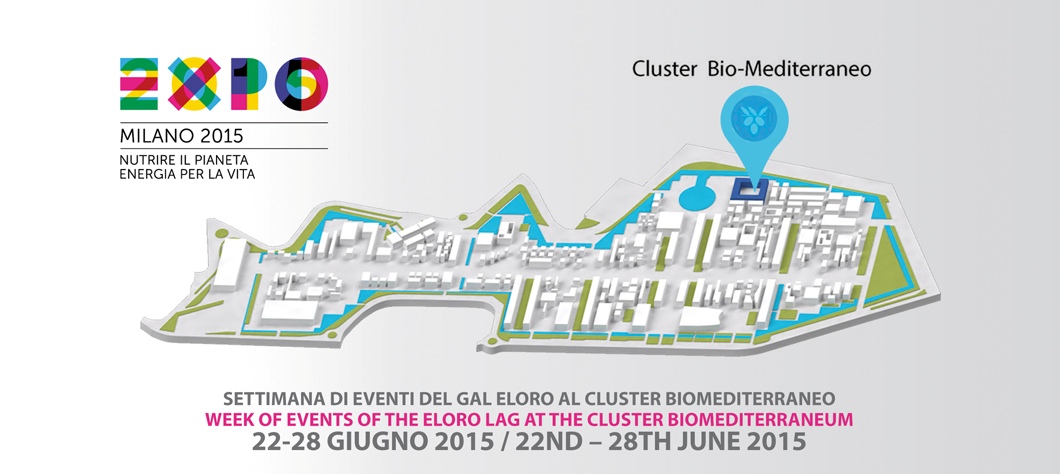
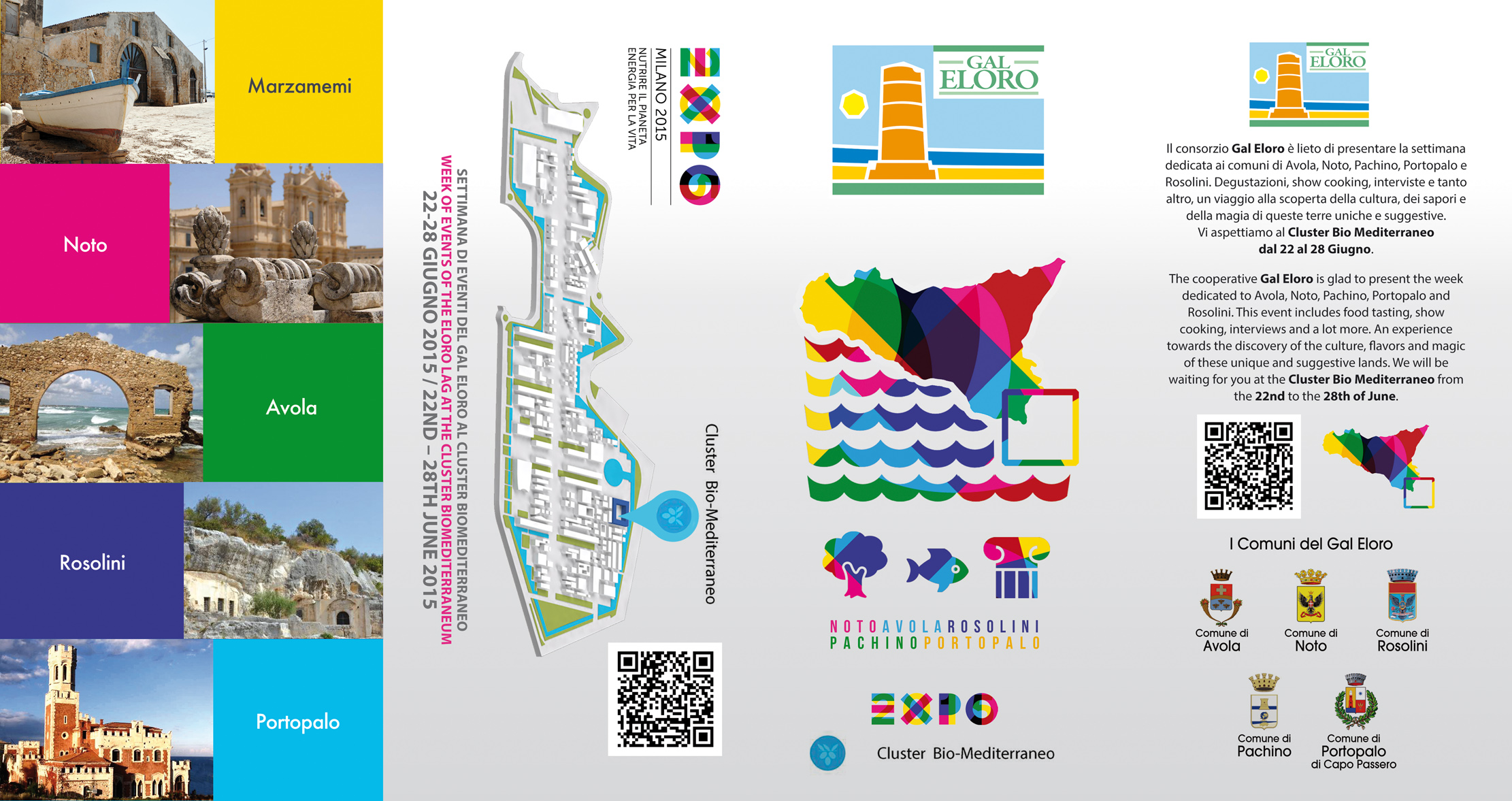
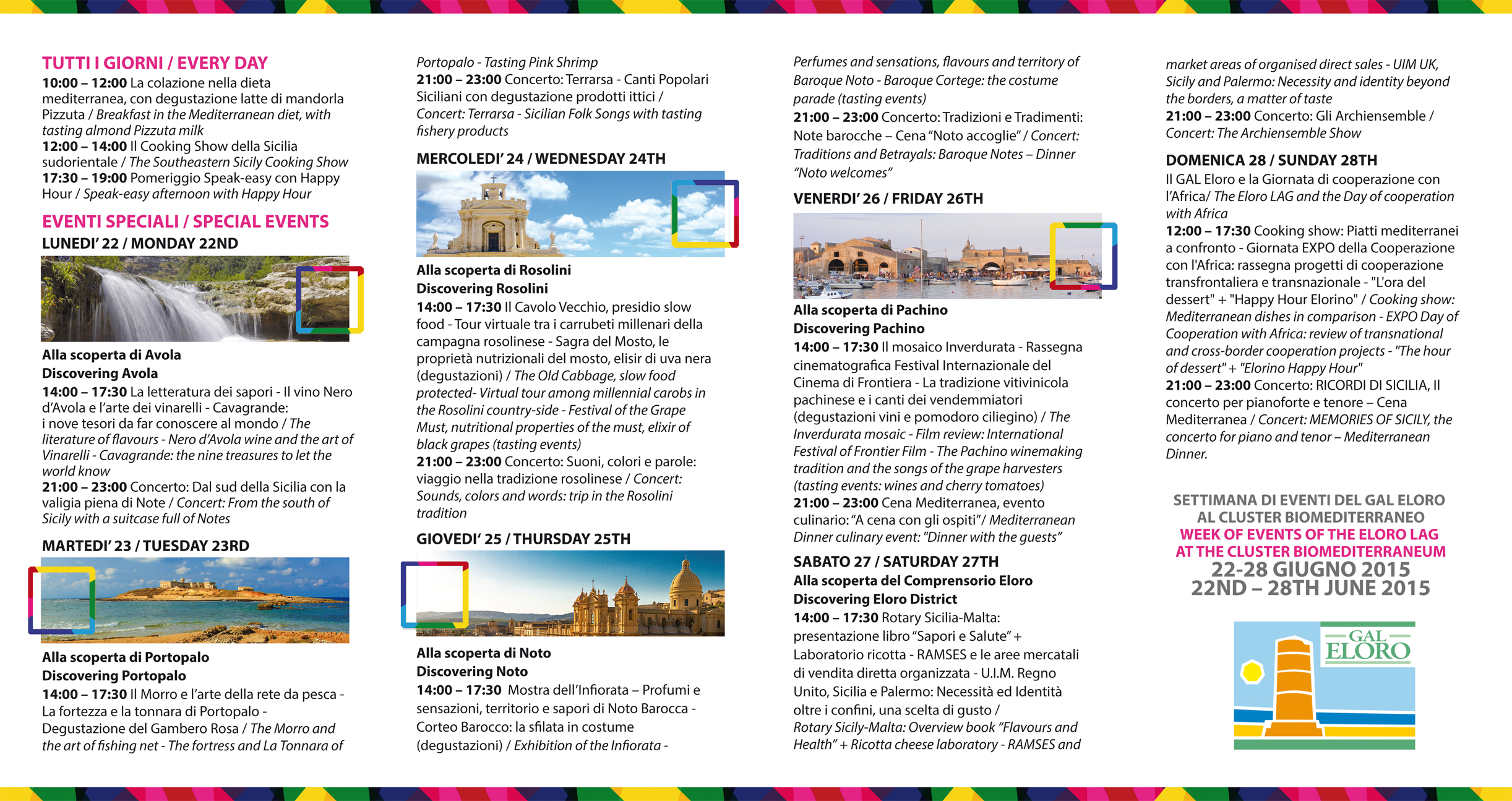

Contrary to what one might think, the so-called "Pachino tomato", in particular variants known as "cherry" and the "cluster" was not born in the area of Pachino: here the cultivation of tomatoes dates back to 1925, but it was for salad tomatoes from normal size and variables.
Similar to that of Pachino tomatoes, round and small enough, sometimes characteristic yellow-reddish, instead were cultivated in all of Southern Italy, at the household level, without any commercial outlet: tomatoes were "from Serbia", for their own consumption during the winter just because they had special skills of aging potential: for this purpose, were kept in bunches held in protected reserves from the seasonal weather, inside or outside of the housing, the latter protected from rain thanks to sloping roofs.
It was only in 1989 that an Israeli producer of seeds, Hazera Genetics, acting through its subsidiary, produced in Sicily two new varieties called Noemi and Rita, then "cluster".
The first reception of the new variant was mistrust, but little by little it had a big success. As the agricultural territory of Pachino and surroundings is particularly suitable for the cultivation of this variant, it took over the trade name "Pachino tomato". Keep in mind that the first seed called Noemi is no longer in production for some time, supplanted by other variants which in the meantime have been derived from it.
Melon Cantaloupe, the most valuable among the netted melon, is cultivated successfully since many years in Sicily, in the Pachino areas.
Characterised by a netted marked peel, it has a round shape with a very small internal cavity; the pulp is salmon color and intense taste sweet and fragrant, the average weight being 1.3 - 1.6 kg. Its great strength, refined taste and its content of vitamins and fiber make it a healthy and highly sought after. 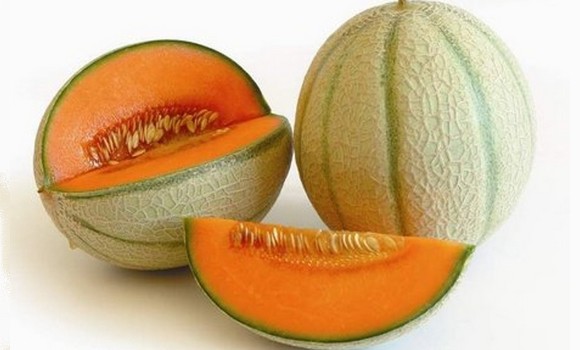
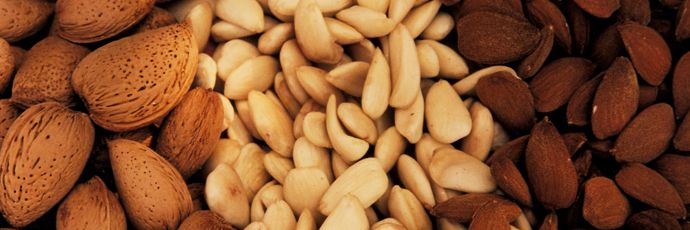 It was selected in the nineteenth century by the botanist Giuseppe Bianca avolese.
It was selected in the nineteenth century by the botanist Giuseppe Bianca avolese.
Flowering starts in January. Almonds ripen between the third week of July and first week of August.
This variety is self-incompatible. Generally, for the collection, you run the downhearting. The yield slipped it between 21 and 23%. The percentage of double seeds is of about 15%.
It is much sought after in the confectionery industry and for the production of confetti.
Along with Roman and Fascionello, the Pizzuta almond is one of the three cultivars protected in Slow Food garrison as "Almond of Avola" or "Almond of Noto".
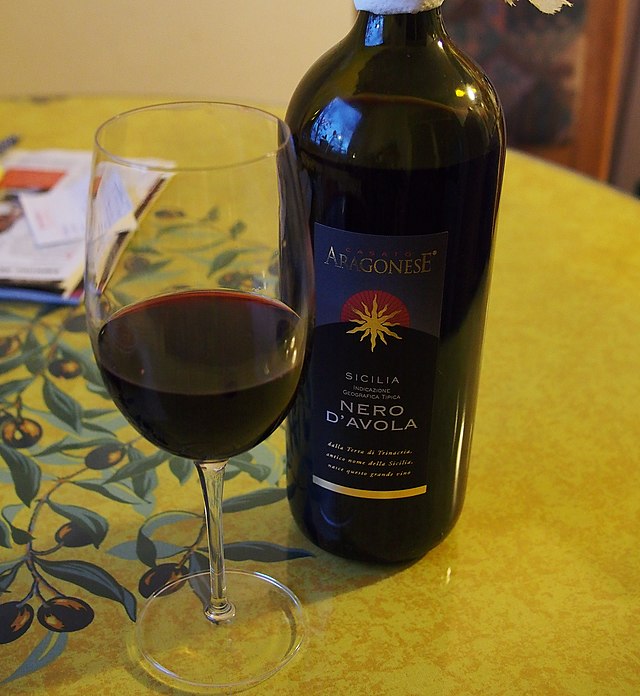 Nero d'Avola is presented to the sight of a nice ruby red, more or less intense depending on the types of the vineyard, its arrangement and aging, has a taste with hints of berry, cherry, plum, in the best areas It presents spicy and balsamic notes.
Nero d'Avola is presented to the sight of a nice ruby red, more or less intense depending on the types of the vineyard, its arrangement and aging, has a taste with hints of berry, cherry, plum, in the best areas It presents spicy and balsamic notes.
Serve at 15-18°C, and goes well with red meats, roasts and mature cheeses.
The Eloro is a wine of Denomination of Controlled Origin reserved for wines produced in the Province of Siracusa, specifically in the municipalities of Noto, Pachino, and Rosolini; and in the municipality of Ispica for the province of Ragusa.
Moscato di Noto is a DOC wine that can be produced in the towns of Noto, Rosolini, Pachino, and Avola in the Syracuse area.

 In the Mediterranean lemon has found considerable interest for cultural and commercial purposes: Sicily is the most important centre of production of lemons in the Mediterranean. The origin of the lemon "Femminello" is unknown. It is likely that this is one of the first introductions of lemon made in Sicily, since the "Femminello" is spread throughout the island thanks to Arabs in the IX century A.C.. The fruit is very variable in size, shape, thickness of the peel, fineness of the epicarpium, number of seeds, and the percentage composition of the juice. The plant is vigorous with a fruited and stretched juice, abundant and fragrant, slightly bitter.
In the Mediterranean lemon has found considerable interest for cultural and commercial purposes: Sicily is the most important centre of production of lemons in the Mediterranean. The origin of the lemon "Femminello" is unknown. It is likely that this is one of the first introductions of lemon made in Sicily, since the "Femminello" is spread throughout the island thanks to Arabs in the IX century A.C.. The fruit is very variable in size, shape, thickness of the peel, fineness of the epicarpium, number of seeds, and the percentage composition of the juice. The plant is vigorous with a fruited and stretched juice, abundant and fragrant, slightly bitter.
The Femminello is the most common and appreciated variety for its abundant production, very suitable for forcing and for fruit resistance to handling and transport.
The first strawberry varieties grew since the early eighteenth century in France. At that time Frézier, an officer of French Engineers sent on a mission in Chile, brought with him on his return some native species from which all cultivated varieties later.
Today strawberry most used is that wild, or wild strawberry, native to Europe and Siberia grows in the woods, clearings and grasslands, up to 1800 m high.
In Sicily the wild strawberry grows wild in thickets of the massive Madonie, Nebrodi Mountains and Mount Etna, but there are also valuable crops in the valleys areas of Ribera, Sciacca and Siracusa, where they produce fruit with a singular history. In fact, it seems that small strawberries grown in this area derived from seedlings brought to Sicily by veterans of the Great War.

The artichoke (Cynara scolymus L) is a perennial herbaceous that shows an erect, branched at the time of flowering, robust, striated longitudinally, equipped with alternate leaves, the height of which varies on average between 80 and 130 cm.
The varieties of artichoke are many, but only a few have a wide spread, while others have merely local importance, and sometimes they just change the name in different places of cultivation.
In the province of Venice are cultivated two varieties of artichoke: the "Violet Chioggia" and "Violet Sant'Erasmo".
For centuries now, in the lagoon of Venice in particular to Sant'Erasmo, Vignole, Lio Piccolo, Malamocco, Mazzorbo, artichokes are produced of high quality, the work and the tenacity of the farmers, who in spite of mode of the global market, can preserve traditional flavours. The variety of Rosolini is undoubtedly the most excellent.
Spread in southern Italy, especially in Sicily and Sardinia. Specimens more to the north are on the promontory of Argentario (Tuscany).
Sturdy tree, 7-10 m high, from spreading tabular habit.
Trunk more or less deformed, with smooth, brown-red bark. Leaves alternate, persistent, composed of 2-5 pairs of oval segments, round or bleed into the apex. The flowers, mostly unisexual, tend to share on separate plants by sex, resulting in a behaviour essentially of dioecious species. Very small and greenish-reddish (no corolla, calyx with 5 sepals soon lapsed), gathered in upright cylindrical clusters, those men with five stamens, the female with a sessile stigma.
The fruit (carob) elongated and flattened, about 2x10-15 cm, blackish to maturity, with crusty epicarp, fleshy mesocarp, sweet and a row of small lenticular seeds, brown, of stone texture.
The growth of the carob tree is slow, his longevity very high, in Rosolini up to thousand years. It features the most hot Mediterranean, where it goes to olive, palm dwarf, filirea more, mastic, myrtle and other shrubs and herbaceous plants.
Siracusa 0931 794131
Pachino 0931 846260
Pachino 0931 593194 - 336 888542
Stefania Busà Pachino 0931 595333 – 331 7565417
Pachino 0931 804111 – 349 5517726
Noto 392 1150944
Carlentini 095 993126 – 329 0611041
Noto 0931 1805181 – 329 0106276
Simona Conti Siracusa 0931 721218 – 338 2999041
Siracusa 333 3253128
Pachino 0931 1847100 – 339 1231922
Giuseppe Squasi Pachino 0931 591944 – 329 2216920
Siracusa 0931 759855 – 338 8079400
Simone Libro Avola 392 7772405
Tonino Sequenzia Siracusa 334 2455014
Rosolini 0931 858586 – 340 8576915
Siracusa 0931 61553 – 392 4671703 alfioneri@libero.it
Noto 0931 835256 – 347 0414472
Avola 0931 831768 - 349 8831464
Concetto Cavarra Siracusa 339 6585785
Noto 0931 810049 – 333 571732
Giuseppe Failla Marzamemi 333 8613160
Siracusa 0931 1850466 – 328 2976343
Noto 0931 839216 – 338 4668257
Avola 0931 821391 – 347 5201915
Sebastiano Tiralongo Avola 377 5292068
Antonio Ficara Siracusa 335 8420551
Carmela Pupillo Siracusa 339 5700843
Bellia Corrado Avola 347 9257136
Calvo Paolo Avola 346 4060556
Sebastiano Munafò Avola 368 644799
Gianpaolo Mauceri Siracusa 328 1293366
Giambattista Curto Modica 0932 950161 – 335 5246568
Franco Bottaro Siracusa 333 2271201
Licitra Luca Noto 331 2595103
Francesco Adelfio Marzamemi 339 4489025
Scollo Carlo Marzamemi 335 8259412
Fabio Moschella Siracusa 335 7748358
Francesco Vescera 333 6166759
Corrado Quartarone 338 8435327
Arfò Salvatore 340 1156150
0931835381 Via Verdi, 1 NOTO
0931591944 Via La Marmora 187 PACHINO
0931841169 Via Marzamemi, 7 PACHINO
0932951228 Contrada Timponelli snc ISPICA
0932950161 Via G. Galilei 4 ISPICA
3476592906 Via Savonarola 74 GIARRATANA
0932984326 Via IV Novembre 5/G VITTORIA
0932 911956 Via MArio Rapisardi, 52 VITTORIA
3337674656 V.le Medaglie D'Oro I Trav n. 2 MODICA
0932867488 Via Bixio, 336 VITTORIA
0932993778 Via Cav. di Vittorio Veneto 46 VITTORIA
3393586829 C.so Umberto 65 CHIARAMONTE GULFI
0932921025 C.da ponte Biviere snc CHIARAMONTE GULFI
0932926166 C.da Dicchiara 69 CHIARAMONTE GULFI
0932874166 Contrada Bidini, snc ACATE
0932948528 Via Modica Giarratana, 130/b1 MODICA
3939299344 Via Gulfi, 213 CHIARAMONTE GULFI
0932950915 Contrada Crocefia, snc ISPICA
0932976992 Via Aldo Moro, 3 GIARRATANA
Contrada Timponelli snc
Via G. Galilei 4 ISPICA RG
Via Savonarola 74 GIARRATANA RG
Via IV Novembre 5/G VITTORIA RG
Via Senia 117 VITTORIA RG
Via Milano 129 VITTORIA RG
C.da Fontanazza snc ISPICA RG
Via delle Industrie 25 MODICA RG
Via MArio Rapisardi, 52 VITTORIA RG
C.da Patria snc CHIARAMONTE GULFI RG
Corso Umberto I 159 MODICA RG
V.le Medaglie D'Oro I Trav n. 2 MODICA RG
Via Bixio, 336 VITTORIA RG
Via Cav. di Vittorio Veneto 46 VITTORIA RG
Via Carlo Pisacane 50 VITTORIA RG
C.da Coffa Zona Artigianale CHIARAMONTE GULFI RG
C.so Umberto 65 CHIARAMONTE GULFI RG
C.da Piano dell'Acqua 71 CHIARAMONTE GULFI RG
Via G. dalle Bande Nere 21/b RAGUSA RG
C.da Cirito 1 CHIARAMONTE GULFI RG
C.da ponte Biviere snc CHIARAMONTE GULFI RG
C.da Dicchiara 69 CHIARAMONTE GULFI RG
Via Tasca 7 SCICLI RG
Contrada Bidini, snc ACATE RG
Via Modica Giarratana, 130/b1 MODICA RG
Via Stesicoro, 50/a RAGUSA RG
Via G. Pisanelli, 73 COMISO RG
Contrada Bufali, snc ISPICA RG
Via Gulfi, 213 CHIARAMONTE GULFI RG
Contrada Crocefia, snc ISPICA RG
Via Aldo Moro, 3 GIARRATANA RG
C.da Zammarra 201 SANTA CROCE CAMERINA RG
Via Fosso Tantillo Pirato, 2b MODICA RG
Via Vanella 112, 4 MODICA RG